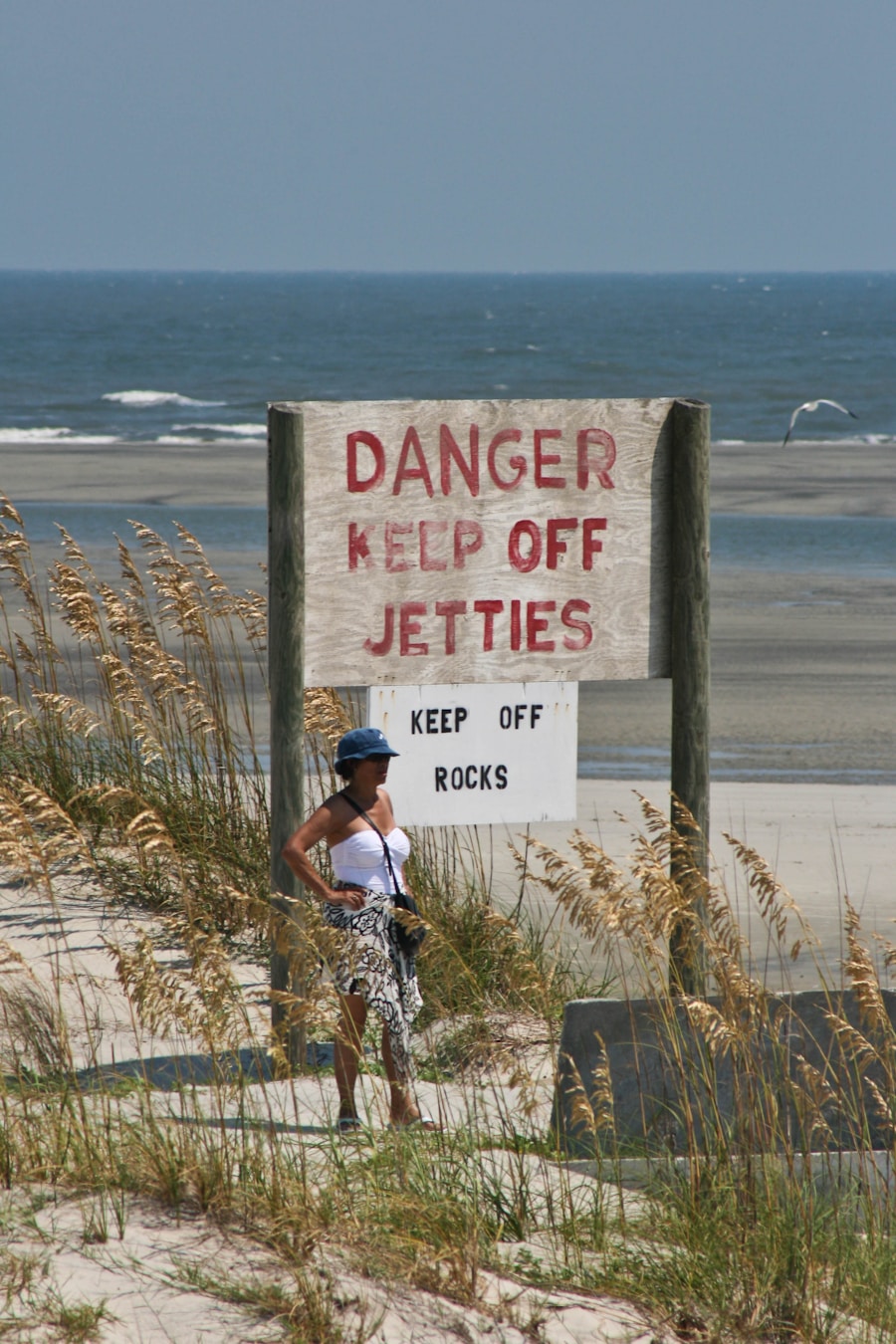Rip currents are one of the most perilous natural phenomena that beachgoers encounter. These powerful, narrow channels of water flow away from the shore, often forming in the surf zone where waves break. They can be deceptively calm, luring swimmers into a false sense of security.
Once caught in a rip current, individuals may find themselves being pulled away from the shore with alarming speed and force. The sheer strength of these currents can quickly exhaust even the most experienced swimmers, making it crucial for beachgoers to understand how to identify and respond to them. To mitigate the risks associated with rip currents, lifeguards often post warning flags and signs at popular beaches.
However, many visitors may overlook these warnings, underestimating the ocean’s power. Education is key; understanding how to spot a rip current can save lives. Signs include choppy water, a difference in water color, or foam and debris moving seaward.
If caught in a rip current, experts advise swimmers to remain calm, conserve energy, and swim parallel to the shore until free from the current’s grip. Recognizing the dangers of rip currents is essential for anyone who enjoys spending time in the ocean.
Key Takeaways
- Rip currents are dangerous and can pull swimmers out to sea, so it’s important to be aware of warning signs and how to escape them.
- Shark attacks are rare, but it’s important to be cautious and avoid swimming in areas where sharks are known to frequent.
- Sunburn and heat exhaustion are common risks at the beach, so it’s important to stay hydrated and use sunscreen.
- Jellyfish stings and sea lice can be painful, so it’s important to be aware of their presence and seek medical attention if stung.
- Beachfront properties can be at risk of erosion and storm damage, so it’s important to consider these hazards when purchasing or renting.
Shark Attacks and Wildlife Hazards
While shark attacks are rare, they capture public attention and evoke fear among beachgoers. The ocean is home to a variety of marine life, and while most species pose little threat to humans, the presence of sharks can be unsettling. Shark attacks are often sensationalized in the media, leading to misconceptions about their frequency and nature.
In reality, sharks typically do not seek out humans as prey; most encounters occur due to curiosity or mistaken identity. Nevertheless, understanding the risks associated with swimming in shark-infested waters is vital for safety. Beachgoers can take precautions to minimize their risk of encountering sharks.
Avoiding swimming during dawn or dusk when sharks are more active, steering clear of areas where fishing is taking place, and refraining from wearing shiny jewelry that may attract attention are all recommended strategies. Additionally, being aware of local shark populations and their behaviors can help swimmers make informed decisions about when and where to enter the water. While the thrill of ocean swimming is undeniable, awareness of wildlife hazards is essential for a safe beach experience.
Sunburn and Heat Exhaustion

The sun’s rays can be both a source of joy and a potential hazard for beachgoers. Prolonged exposure to sunlight can lead to painful sunburns, which not only cause discomfort but also increase the risk of skin cancer over time. Many individuals underestimate the intensity of UV radiation, especially on cloudy days or when near reflective surfaces like water or sand.
It is crucial for beachgoers to apply sunscreen generously and frequently, opting for broad-spectrum protection with a high SPF rating. In addition to sunburn, heat exhaustion is another significant concern during beach outings. Spending hours under the sun without adequate hydration can lead to dehydration and heat-related illnesses.
Symptoms may include dizziness, nausea, and fatigue. To combat these risks, individuals should take regular breaks in shaded areas, drink plenty of water, and wear protective clothing such as hats and sunglasses. By prioritizing sun safety and hydration, beachgoers can enjoy their time by the water while minimizing health risks.
Jellyfish Stings and Sea Lice
| Year | Jellyfish Stings | Sea Lice Cases |
|---|---|---|
| 2018 | 150,000 | 12,000 |
| 2019 | 160,000 | 14,500 |
| 2020 | 155,000 | 13,200 |
Jellyfish stings are an unfortunate reality for many beach enthusiasts. These gelatinous creatures can be difficult to spot in the water, and their tentacles can deliver painful stings that cause irritation and discomfort. Some species possess venom that can lead to more severe reactions, particularly in sensitive individuals or those allergic to their toxins.
Awareness of jellyfish season and local species can help swimmers avoid encounters with these marine animals. Sea lice, or tiny larvae from certain jellyfish species, present another hazard for beachgoers. These microscopic creatures can cause skin irritation that mimics a rash or hives.
Often mistaken for an allergic reaction or other skin conditions, sea lice stings can be uncomfortable and may require treatment to alleviate symptoms. To reduce the risk of jellyfish stings or sea lice encounters, swimmers should consider wearing protective clothing such as rash guards when swimming in areas known for these hazards. Understanding these risks allows beachgoers to take proactive measures for a more enjoyable experience.
Beachfront Property Hazards
Owning or renting beachfront property comes with its own set of challenges and hazards. Coastal erosion is a significant concern for property owners, as rising sea levels and storm surges can threaten homes situated close to the shoreline. Regular maintenance and awareness of local environmental changes are essential for protecting investments in beachfront real estate.
Additionally, properties near the ocean may face unique insurance challenges due to their vulnerability to natural disasters such as hurricanes or flooding. Beyond environmental concerns, beachfront properties may also present safety hazards related to access and infrastructure. Steep dunes or unstable sand can pose risks for children and adults alike.
Property owners must ensure that walkways are safe and well-maintained while providing adequate signage about potential dangers. Furthermore, ensuring that emergency services are accessible in case of accidents is crucial for maintaining safety in these idyllic yet potentially hazardous locations.
Crime and Safety Concerns

While beaches are often associated with relaxation and fun, crime can be a concern in popular tourist areas. Theft is one of the most common issues faced by beachgoers; unattended belongings left on the sand can attract opportunistic thieves. To mitigate this risk, individuals should avoid leaving valuables unattended and consider using lockers or secure storage options provided by some beaches.
In addition to theft, other safety concerns may arise in crowded beach environments. Altercations between individuals or groups can escalate quickly in high-stress situations, particularly during peak tourist seasons when tensions may run high. Beachgoers should remain vigilant and aware of their surroundings while also being prepared to seek help from law enforcement if necessary.
By prioritizing personal safety and being mindful of potential risks, individuals can enjoy their time at the beach with greater peace of mind.
Traffic and Pedestrian Dangers
The areas surrounding popular beaches often experience heavy traffic congestion during peak seasons. This influx of vehicles can create hazardous conditions for pedestrians attempting to navigate busy streets or cross roads safely. Drivers may become distracted by the sights and sounds of the beach environment, leading to an increased risk of accidents involving pedestrians or cyclists.
To enhance safety for everyone involved, local authorities often implement measures such as designated crosswalks, traffic signals, and speed limits near beach access points. However, it remains essential for pedestrians to exercise caution when traversing these areas. Wearing bright clothing, using crosswalks whenever possible, and remaining alert while walking near roadways can significantly reduce the risk of accidents.
By fostering a culture of safety on both sides—drivers being attentive and pedestrians being cautious—beach communities can create a safer environment for all.
Alcohol and Party Culture Risks
The beach is often synonymous with relaxation and celebration, leading many individuals to indulge in alcohol consumption during their outings. While enjoying a drink by the shore can enhance the experience, excessive drinking poses significant risks that can quickly turn a fun day into a dangerous situation. Alcohol impairs judgment and coordination, increasing the likelihood of accidents both in the water and on land.
Moreover, party culture at beaches can lead to rowdy behavior that may disturb other visitors or escalate into confrontations. It is essential for individuals to recognize their limits when consuming alcohol and to remain respectful of others sharing the space. Establishing designated drivers or using rideshare services can help ensure safe transportation after a day at the beach.
By promoting responsible drinking habits and fostering a culture of respect among beachgoers, everyone can enjoy a safe and enjoyable experience by the water. In conclusion, while beaches offer countless opportunities for enjoyment and relaxation, they also present various hazards that require awareness and caution. From natural dangers like rip currents and wildlife encounters to human-related risks such as crime and traffic concerns, understanding these potential threats is crucial for ensuring safety at coastal destinations.
By taking proactive measures—such as educating oneself about local conditions, practicing sun safety, and promoting responsible behavior—beachgoers can create memorable experiences while minimizing risks associated with their time by the ocean.
Myrtle Beach has gained a reputation for being a dangerous destination due to various factors such as crime rates and natural disasters. According to a recent article on hangout-bridges.com, the city has seen an increase in criminal activities in recent years, making it a risky place for tourists and residents alike. Additionally, the article discusses how the lack of proper infrastructure and emergency preparedness has contributed to the dangers faced by those living or visiting Myrtle Beach.
FAQs
What are the crime rates in Myrtle Beach?
Myrtle Beach has a higher crime rate compared to the national average. The city’s crime rate is 87% higher than the national average, with a 1 in 17 chance of being a victim of crime.
What are the most common types of crimes in Myrtle Beach?
The most common types of crimes in Myrtle Beach include property crimes such as theft, burglary, and motor vehicle theft, as well as violent crimes such as assault, robbery, and shootings.
What factors contribute to the high crime rate in Myrtle Beach?
Several factors contribute to the high crime rate in Myrtle Beach, including a high volume of tourists and visitors, a large population of seasonal residents, and a concentration of bars, clubs, and entertainment venues.
What measures are being taken to address the crime rate in Myrtle Beach?
Local law enforcement agencies in Myrtle Beach are implementing various measures to address the crime rate, including increasing police presence in high-crime areas, implementing community policing initiatives, and collaborating with other agencies to target criminal activity.
Is it safe to visit Myrtle Beach despite the high crime rate?
While Myrtle Beach does have a higher crime rate, it is still a popular tourist destination and many visitors have a safe and enjoyable experience. It is important for visitors to be aware of their surroundings, take precautions, and follow safety guidelines provided by local authorities.









